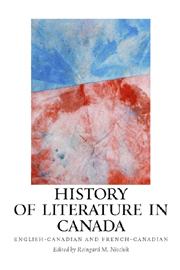Book contents
- Frontmatter
- Contents
- Acknowledgments
- Introduction: Writing a History of Literature in Canada
- I Beginnings
- II The Literature of New France, 1604–1760
- III The Literature of British Canada, 1763–1867
- IV From the Dominion to the Territorial Completion of the Nation, 1867–1918
- V The Modern Period, 1918–1967
- 11 Politics and Literature between Nationalism and Internationalism
- 12 English-Canadian Poetry, 1920–1960
- 13 The English-Canadian Novel and the Displacement of the Romance
- 14 The Modernist English-Canadian Short Story
- 15 Early English-Canadian Theater and Drama, 1918–1967
- 16 French Canada from the First World War to 1967: Historical Overview
- 17 French-Canadian Poetry up to the 1960s
- 18 The French-Canadian Novel between Tradition and Modernism
- 19 The French-Canadian Short Story
- 20 French-Canadian Drama from the 1930s to the Révolution tranquille
- VI Literature from 1967 to the Present
- Further Reading
- Notes on the Contributors
- Index
13 - The English-Canadian Novel and the Displacement of the Romance
from V - The Modern Period, 1918–1967
Published online by Cambridge University Press: 12 September 2012
- Frontmatter
- Contents
- Acknowledgments
- Introduction: Writing a History of Literature in Canada
- I Beginnings
- II The Literature of New France, 1604–1760
- III The Literature of British Canada, 1763–1867
- IV From the Dominion to the Territorial Completion of the Nation, 1867–1918
- V The Modern Period, 1918–1967
- 11 Politics and Literature between Nationalism and Internationalism
- 12 English-Canadian Poetry, 1920–1960
- 13 The English-Canadian Novel and the Displacement of the Romance
- 14 The Modernist English-Canadian Short Story
- 15 Early English-Canadian Theater and Drama, 1918–1967
- 16 French Canada from the First World War to 1967: Historical Overview
- 17 French-Canadian Poetry up to the 1960s
- 18 The French-Canadian Novel between Tradition and Modernism
- 19 The French-Canadian Short Story
- 20 French-Canadian Drama from the 1930s to the Révolution tranquille
- VI Literature from 1967 to the Present
- Further Reading
- Notes on the Contributors
- Index
Summary
ACCORDING TO NORTHROP FRYE, English-Canadian literature is marked by a five-century-long oscillation between the romantic tendency, on the one hand, moving in the direction of myth and metaphor and their formulaic units, and the realistic tradition, on the other hand, moving in the opposite direction, displacing or adjusting such improbable formulas so as to produce verisimilitude (Frye 1976, 36–37). English-Canadian cultural production can thus be situated at opposite extremes. In the period between 1918 and 1967, a large part is grounded in the themes and motifs of the folktale, in the structures of the mythopoeic or marvelous, and in the implausible, erotic, and often violent world of romance. Simultaneously, a large part of cultural production, derivative of a society fascinated by history as well as by social observation, has long been anchored in documentary or expository material for which English-Canadian film, poetry, life writing, and historical and historiographical fiction are well known.
Among the best-known writers resorting to mythical and romantic formulas, and claiming entitlement to the freedom to “lie” — that is, to make full use of the imaginative faculty — is the American Nathaniel Hawthorne. In the introductory chapter to The Scarlet Letter: A Romance (1850), entitled “The Custom-house,” Hawthorne provided the framework for an artistic manifesto on the prerogatives of the “romance writer” to create a “neutral territory, somewhere between the real world and fairyland, where the Actual and the Imaginary may meet, and each imbue itself with the nature of the other” (66).
- Type
- Chapter
- Information
- History of Literature in CanadaEnglish-Canadian and French-Canadian, pp. 174 - 193Publisher: Boydell & BrewerPrint publication year: 2008



